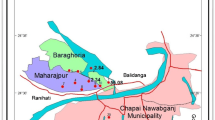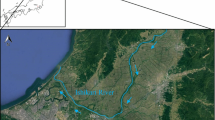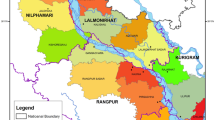Abstract
Arsenic (As) contamination of sediments and waters is known from Bengal and other parts of eastern and central India. However, there is paucity of reports that document occurrence of As in Quaternary sediments from western India. In this paper, we report the enrichment of As in the Quaternary sediments of Ankaleshwar area in the western Indian state of Gujarat. Twenty-five surface and five profile samples were analyzed that indicated spatial and vertical distribution of As in the sediments. The As content of fine size fractions (<63 μm) compared with upper continental crust (UCC) and standard shale indicates anomalous As enrichment that is supported by moderate to high geo-accumulation index (Igeo) as well as pollution index (Pi). Enrichment of As is seen in surface sediments from the industrial and urban land use regions, followed by oil field and agricultural land suggesting strong influence of anthropogenic factors. Although the arsenic concentration decreases with depth, the relatively higher values of As coupled with Igeo and Pi index values suggest downward migration of metal that is likely to contaminate groundwater. This calls for urgent remediation so that the ill effects of As contamination can be minimized.






Similar content being viewed by others
References
Alam, M. G. M., Allinson, G., Stagnatti, F., Tanaka, A., & Westbrooke, M. (2002). Arsenic contamination in Bangladesh groundwater: a major environmental and social disaster. International Journal of Environmental Health Research, 12, 236–253.
Ansari, A. A., Singh, I. B., Tobschall, H. J. (1998). Role of monsoon rain on concentrations and dispersion patterns of metal pollutants in sediments and soils of the Ganga Plain, Environmental Geology 39(3–4).
Barringer, J. L., & Reilly, P. A. (2013). Arsenic in groundwater: a summary of sources and the biogeochemical and hydrogeologic factors affecting arsenic occurrence and mobility (pp. 83–116). INTECH Open Access Publisher.
Bhandari, S., Rachna, R., Maurya, D. M., & Chamyal, L. S. (2001). Formation and erosion of Holocene alluvial fans along the Narmada-Son Fault around Rajpipla in the lower Narmada Basin, Western India. Journal of the Geological Society of India, 58, 519–531.
Birch, G., & Taylor, S. (1999). Source of heavy metals in sediments of the Port Jackson estuary, Australia. The Science of the Total Environment, 227, 123–138.
Bruno, K. (1995). Chemical Pollution: Gujarat’s toxic corridor. The Hindu Society of the Environment, 29(9), 163–166.
Casper, S. T., Mehra, A., Farago, M. E., & Gill, R. A. (2004). Contamination of Surface Soils, River Water and Sediments by Trace Metals from Copper Processing Industry in the Churnet River Valley, Staffordshire, UK. Environmental Geochemistry and Health, 1, 59–67.
Chamyal, L. S., Maurya, D. M., Bhandari, S., & Rachna, R. (2002). Late Quaternary geomorphic evolution of the lower Narmada valley, Western India: implications for neotectonic activity along the Narmada-Son Fault. Geomorphology, 46, 177–202.
CPCB (1996) Inventorisation of hazardous waste generation in five districts (Ahmedabad, Vadodara, Bharuch, Surat, and Valsad) of Gujarat. Central Pollution Control Board (Ministry of Environment and Forests, Government of India) ISBN 8186396632.
Fakoyade, S. O., & Olu-Owolabi, B. I. (2003). Heavy metal contamination of roadside topsoil in Osagbo, Nigeria: its relationship to traffic density and proximity to highways. Environmental Geology, 44, 50–157.
Fakoyade, S. O., & Onianwa, P. C. (2002). Heavy metal contamination of soil and bioaccumulation in Guinea grass, around Ikeja Industrial Estate, Lagos, Nigeria. Environmental Geology, 43, 145–150.
GSI (2002) District Resource Map (1:50,000) Geological Survey of India, Bharuch District, Gujarat.
Hileman, B. (2007). Arsenic in chicken production. Chemical Engineering News, 85, 34–35.
Jain, C. K., Malik, D. S., & Yadav, R. (2007). Metal Fractionation Study on Bed Sediments of Lake Nainital, Uttaranchal, India. Environmental Monitoring and Assessment, 130, 129–139.
Krishna, A. K., & Govil, P. K. (2007). Soil contamination due to heavy metals from an industrial area of Surat, Gujarat, Western India. Environmental Monitoring and Assessment, 124(1–3), 263–275.
Matera, V., & LeHecho, I. (2001). Arsenic behavior in contaminated soils: mobility and speciation. In H. M. Selim & D. L. Sparks (Eds.), Heavy metals release in soils (pp. 207–235). Boca Raton: CRC Press.
Muller, G. (1969). Index of geoaccumulation in sediments of the Rhine River. GeoJournal, 2, 109–118.
Ning, R. Y. (2002). Asenic ermoval by reverse osmosis. Desalinisation, 143, 237–241.
Pandey, P. K., Yadav, S., Nair, S., & Bhui, A. (2002). Arsenic contamination of the environment. A new perspective from central-east India. Environment International, 28, 235–245.
Raymahashay, B. C., & Khare, A. S. (2003). The arsenic cycle in Late Quaternary fluvial sediments: Mineralogical considerations. Current Science, 84, 1102–1104.
Santillo, D., Stephenson. A., Labunskaia, I., & Siddorn, J. (1996). A preliminary survey of waste management practices in the chemical industrial sector in India: Consequences for environmental quality and human health. Part I. Gujarat. Greenpeace Research Laboratories Technical Note 96/8.
Singh, S., & Kumar, M. (2006). Heavy metal load of soil, water and vegetables in periurban Delhi. Environmental Monitoring and Assessment, 120, 71–79.
Sutherland, R. A. (2000). Bed sediment-associated trace metals in an urban stream, Oahu, Hawaii. Environmental Geology, 39(6), 611.
Suyash, K., & Pawar, N. J. (2008). Quantifying spatio-temporal variations in heavy metal enormity of groundwaters from Ankaleshwar area: GIS-based Normalized Difference Dispersal Index mapping. Current Science, 94(7), 905–910.
Suyash, K., & Pawar, N. J. (2010). Site-specific accentuation of heavy metals in groundwaters from Ankaleshwar industrial estate, India. Environmental Earth Sciences. doi:10.1007/s12665-010-0879-6.
Suyash, K., Shirke, K. D., & Pawar, N. J. (2008). GIS-based colour composites and overlays to delineate heavy metal contamination zones in the shallow alluvial aquifers, Ankaleshwar industrial estate, south Gujarat, India. Environmental Geology, 54, 117–129.
Upadhyay, A. K., Gupta, K. K., Sircar, J. K., Deb, M. K., & Mundhara, G. L. (2007). Dominance of lithogenic effect for nickel, cobalt, chromium and mercury as found in freshly deposited sediments of the river Subernarekha, India. Environmental Geology, 51, 1447–1453.
Xie, X., Wang, Y., Su, C., Liu, H., Duan, M., & Xie, Z. (2008). Arsenic mobilization in shallow aquifers of Datong Basin: Hydrochemical and mineralogical evidences. Journal of Geochemical Exploration, 98, 107–115.
Acknowledgments
Authors would like to thank the Head of the Department of Geology, S.P.Pune University, Pune, for providing necessary facilities. Financial assistance by DST, Government of India, under SSS program is gratefully acknowledged. The first author thankfully acknowledges the financial support by DST as a Research Fellow. Authors also acknowledge the anonymous reviewers for many meaningful suggestions that led to considerable improvement in the quality of the paper.
Author information
Authors and Affiliations
Corresponding author
Rights and permissions
About this article
Cite this article
Shirke, K.D., Pawar, N.J. Enrichment of arsenic in the Quaternary sediments from Ankaleshwar industrial area, Gujarat, India: an anthropogenic influence. Environ Monit Assess 187, 593 (2015). https://doi.org/10.1007/s10661-015-4815-9
Received:
Accepted:
Published:
DOI: https://doi.org/10.1007/s10661-015-4815-9




